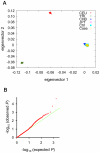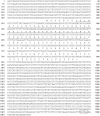Common variants in a novel gene, FONG on chromosome 2q33.1 confer risk of osteoporosis in Japanese
- PMID: 21573128
- PMCID: PMC3089633
- DOI: 10.1371/journal.pone.0019641
Common variants in a novel gene, FONG on chromosome 2q33.1 confer risk of osteoporosis in Japanese
Abstract
Osteoporosis is a common disease characterized by low bone mass, decreased bone quality and increased predisposition to fracture. Genetic factors have been implicated in its etiology; however, the specific genes related to susceptibility to osteoporosis are not entirely known. To detect susceptibility genes for osteoporosis, we conducted a genome-wide association study in Japanese using ∼270,000 SNPs in 1,747 subjects (190 cases and 1,557 controls) followed by multiple levels of replication of the association using a total of ∼5,000 subjects (2,092 cases and 3,114 controls). Through these staged association studies followed by resequencing and linkage disequilibrium mapping, we identified a single nucleotide polymorphism (SNP), rs7605378 associated with osteoporosis. (combined P = 1.51×10(-8), odds ratio = 1.25). This SNP is in a previously unknown gene on chromosome 2q33.1, FONG. FONG is predicted to encode a 147 amino-acid protein with a formiminotransferase domain in its N-terminal (FTCD_N domain) and is ubiquitously expressed in various tissues including bone. Our findings would give a new insight into osteoporosis etiology and pathogenesis.
Conflict of interest statement
Figures




Similar articles
-
Association Study between the FTCDNL1 (FONG) and Susceptibility to Osteoporosis.PLoS One. 2015 Oct 22;10(10):e0140549. doi: 10.1371/journal.pone.0140549. eCollection 2015. PLoS One. 2015. PMID: 26492493 Free PMC article.
-
Single nucleotide polymorphisms in bone turnover-related genes in Koreans: ethnic differences in linkage disequilibrium and haplotype.BMC Med Genet. 2007 Nov 26;8:70. doi: 10.1186/1471-2350-8-70. BMC Med Genet. 2007. PMID: 18036257 Free PMC article.
-
Identification of a glutamic acid repeat polymorphism of ALMS1 as a novel genetic risk marker for early-onset myocardial infarction by genome-wide linkage analysis.Circ Cardiovasc Genet. 2013 Dec;6(6):569-78. doi: 10.1161/CIRCGENETICS.111.000027. Epub 2013 Oct 11. Circ Cardiovasc Genet. 2013. PMID: 24122612
-
[Genome-wide association study for Osteoporosis].Clin Calcium. 2016 Apr;26(4):537-43. Clin Calcium. 2016. PMID: 27013623 Review. Japanese.
-
[The identification of susceptibility gene for common type 2 diabetes by high-density SNPs mapping].Tanpakushitsu Kakusan Koso. 2001 Dec;46(16 Suppl):2619-24. Tanpakushitsu Kakusan Koso. 2001. PMID: 11802440 Review. Japanese. No abstract available.
Cited by
-
Pharmacogenomics Study for Raloxifene in Postmenopausal Female with Osteoporosis.Dis Markers. 2020 Aug 31;2020:8855423. doi: 10.1155/2020/8855423. eCollection 2020. Dis Markers. 2020. PMID: 32934756 Free PMC article.
-
The Effect of Some Polymorphisms in Vitamin D Receptor Gene in Menopausal Women with Osteoporosis.J Clin Diagn Res. 2016 Jun;10(6):RC06-10. doi: 10.7860/JCDR/2016/17147.8006. Epub 2016 Jun 1. J Clin Diagn Res. 2016. PMID: 27504361 Free PMC article.
-
A short history of the genome-wide association study: where we were and where we are going.Genomics Inform. 2012 Dec;10(4):220-5. doi: 10.5808/GI.2012.10.4.220. Epub 2012 Dec 31. Genomics Inform. 2012. PMID: 23346033 Free PMC article.
-
Association of vitamin D receptor BsmI gene polymorphism with risk of osteoporosis: a meta-analysis of 41 studies.Mol Biol Rep. 2013 Jan;40(1):497-506. doi: 10.1007/s11033-012-2086-x. Epub 2012 Oct 11. Mol Biol Rep. 2013. PMID: 23054016
-
Association Study between the FTCDNL1 (FONG) and Susceptibility to Osteoporosis.PLoS One. 2015 Oct 22;10(10):e0140549. doi: 10.1371/journal.pone.0140549. eCollection 2015. PLoS One. 2015. PMID: 26492493 Free PMC article.
References
-
- Reginster JY, Burlet N. Osteoporosis: a still increasing prevalence. Bone. 2006;38:S4–9. - PubMed
-
- Peacock M, Turner CH, Econs MJ, Foroud T. Genetics of osteoporosis. Endocr Rev. 2002;23:303–326. - PubMed
-
- Liu YZ, Liu YJ, Recker RR, Deng HW. Molecular studies of identification of genes for osteoporosis: the 2002 update. J Endocrinol. 2003;177:147–196. - PubMed
-
- Ralston SH, de Crombrugghe B. Genetic regulation of bone mass and susceptibility to osteoporosis. Genes Dev. 2006;20:2492–2506. - PubMed
Publication types
MeSH terms
Substances
LinkOut - more resources
Full Text Sources
Medical
Molecular Biology Databases

